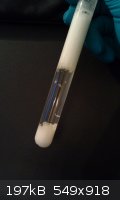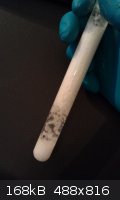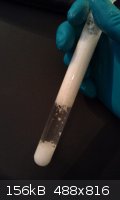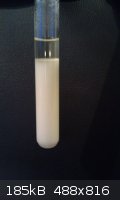| Pages:
1
2 |
DNA
Hazard to Others
  
Posts: 191
Registered: 11-6-2003
Location: @moon
Member Is Offline
Mood: Experimenting
|
|
Yesterday I did a test with plumber's putty and actually it works quite well.
I didn't try PETN but an inert fine powder, and I managed in first instance without any addition of plasticizer to add 70% of inert material to the
plumber's putty.
Definately with a bit of plasticizer there could be added more, and improve the plasticity.
Now when you mold it it becomes a bit too "dry".

[Edited on 27-1-2011 by DNA]
|
|
|
Microtek
National Hazard
   
Posts: 838
Registered: 23-9-2002
Member Is Offline
Mood: No Mood
|
|
"Plumber's putty" is (as far as I can see) not a well defined material, but the one MSDS that I could find which actually stated the ingredients (and
not just a "no hazardous components") contained about 80% inerts. If you remove all these inerts (CaCO3 and others) you could doubtlessly get better
mechanical properties. Oh, and I very much doubt that a plasticizer would do any good in this case (except as a diluent), since there is no polymeric
binder in it.
|
|
|
DNA
Hazard to Others
  
Posts: 191
Registered: 11-6-2003
Location: @moon
Member Is Offline
Mood: Experimenting
|
|
It is called silicon kit over here. It is not exactly the plumbers putty. I put that in the post because I found no exact translation, this one
doesn't contain CaCO3. It is actually the stuff they use to glue aquaria with. It is transparent.
Polydimethylsiloxane based.
[Edited on 27-1-2011 by DNA]
|
|
|
Jimbo Jones
Hazard to Others
  
Posts: 102
Registered: 15-10-2009
Member Is Offline
Mood: No Mood
|
|
PDMS is very useful for some plastic explosive formulations.
http://en.wikipedia.org/wiki/Brake_fluid
http://en.wikipedia.org/wiki/Dimethyl_polysiloxane
http://en.wikipedia.org/wiki/DOT_5.1
It’s easy to obtain and contain two other important plasticizer - di-ethylhexyl sebacate and tributyl phosphate. It’s mentioned even in the KIPE
II, but the patents are in the net too. Maybe it’s posible to use just DOT 5.1. Who knows….
On other hand, if you search for high quality polybutene, you may look here.
http://www.birdbgone.com/images/stories/msds/GelMSDS.pdf
|
|
|
DNA
Hazard to Others
  
Posts: 191
Registered: 11-6-2003
Location: @moon
Member Is Offline
Mood: Experimenting
|
|
Just for the information in original C4 they use the following PIB:
Vistanex MML-120
Which has a molecular weight of 1450000 g/mol - 1870000 g/mol.
Or they use BASF Opanol B150 or B200
Which respectively have the following molecular weights:
2,6*10^6 and 4*10^6
The binder then is 9,9% of C4 where of 23% is PIB and the rest is plasticizer and motor oil.
http://www.dtic.mil/ndia/2009insensitive/5Azastrow.pdf
Here results from shaving PETN crystals down after recrystalization from acetone and then drowning with 50*C water.
[Edited on 31-1-2011 by DNA]
   
The picture on the right is the acetone which is crashed with warm water, and the 3 on the left are the already formed crystals where warm water was
added and shaken to shave them (which didn't happen so to see).
Could it be that the shaved down crystals are denser then the quickly precipitated (crashed out) crystals?
[Edited on 31-1-2011 by DNA]
[Edited on 31-1-2011 by DNA]
|
|
|
TETS
Harmless

Posts: 2
Registered: 10-11-2009
Member Is Offline
Mood: No Mood
|
|
Hi, I have a good news guys. Did you know most of mouse and rat glue traps use PIB as main ingredients? Now you just need a plasticizer and little
motor oil. If you like rubbery sheet Explosive with though consistency use more binder ,less plasicizer and vice versa in the case of putty. Do not
forget this general rule that for good plastic 30% of the crystals must be superfine ( pass through 320 mesh);you could do it by carefully grind this
portion with mortar while it's damp, or alternatively spray solution of petn in acetone into the water ( As they do in industrial scale).
|
|
|
greenlight
National Hazard
   
Posts: 717
Registered: 3-11-2014
Member Is Offline
Mood: Energetic
|
|
Has anyone actually made a successful sheet explosive on here that keeps its form over a sensible temperature range?
It seems like it would be interesting to use.
I found the formulation for Detasheet C by Dupont. It says it contains 63% PETN, 8% Nitrocellulose (12.34% nitrogen) and 29% acetyl tributyl citrate.
Someone above said you don't need the acetyl tributyl citrate and it can be substituted with diethyl or dioctyl phthalate with okay results.
Nitro-genes said to use polystyrene and PGDN but would this be okay to handle head ache wise?
Is the sheet explosive rolled similarly to plastic explosive or do the ingredients need to be dissolved in a solvent and the solvent evaporated
beforehand?
The only use for an atomic bomb is to keep somebody else from using one.
George Wald
|
|
|
| Pages:
1
2 |